Do you want to increase your visibility with AWS marketplace integration? Well, we have got your covered.
In the ever-evolving digital landscape, establishing a strong online presence and maximizing your visibility is essential for the success of your business.
As businesses strive to expand their reach and tap into new markets, the integration of products and services with AWS Marketplace emerges as a strategic move.
Amazon Web Services’ (AWS) online software store, AWS Marketplace, offers a comprehensive platform for businesses to gain global exposure and drive growth by leveraging its vast customer base.
In this in-depth guide, we will delve into the intricacies of AWS Marketplace integration, exploring the benefits, step-by-step process, and expert tips to enhance your visibility effectively.
What is AWS Marketplace?
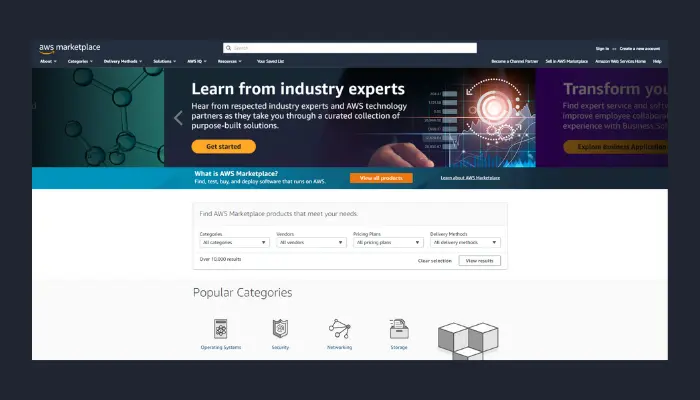
AWS Marketplace is a digital platform that connects software vendors with customers seeking cloud-based solutions.
It offers a diverse range of software categories, including security, data analytics, machine learning, and more.
Moreover, the marketplace simplifies the process of discovering, procuring, and deploying software on AWS, making it an attractive avenue for businesses looking to expand their offerings.
Now that we understand AWS marketplace, we are one step closer to understanding AWS integration. But first, let’s look at the reasons to choose AWS marketplace.
Why Choose AWS Marketplace?
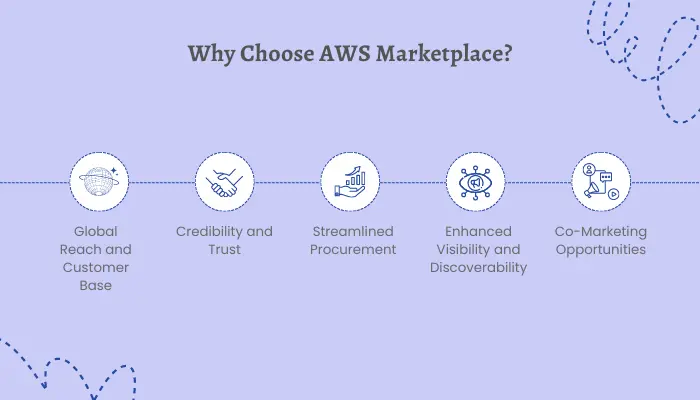
In the debate of AWS vs Azure vs Google Cloud, why should you go with Amazon web service? Well, this is a question that a lot of people ask.
You see, with AWS Marketplace Integration, you unlock numerous benefits that contribute to your overall business success:
Global Reach and Customer Base
AWS Marketplace integration can boast a massive customer base that spans across industries and geographies.
This broad reach instantly exposes your product to a diverse audience, accelerating your market penetration.
Credibility and Trust
The rigorous standards enforced by AWS lend credibility to products listed on the marketplace.
In addition, customers often trust solutions available through AWS Marketplace due to the platform’s emphasis on security, quality, and reliability.
Streamlined Procurement
AWS Marketplace integration also simplifies the purchasing process for customers.
With intuitive navigation and seamless integration, customers can quickly find, evaluate, and deploy your product, leading to higher adoption rates.
Enhanced Visibility and Discoverability
The platform’s user-friendly interface and search functionalities make it easier for customers to find your product.
Moreover, this enhanced discoverability increases the likelihood of attracting potential users who are actively seeking solutions in your niche.
Co-Marketing Opportunities
AWS Marketplace offers co-marketing opportunities, allowing you to collaborate with AWS on joint marketing campaigns and initiatives.
This collaboration amplifies your visibility by leveraging AWS’s established brand and reach.
The Benefits of AWS Marketplace Integration
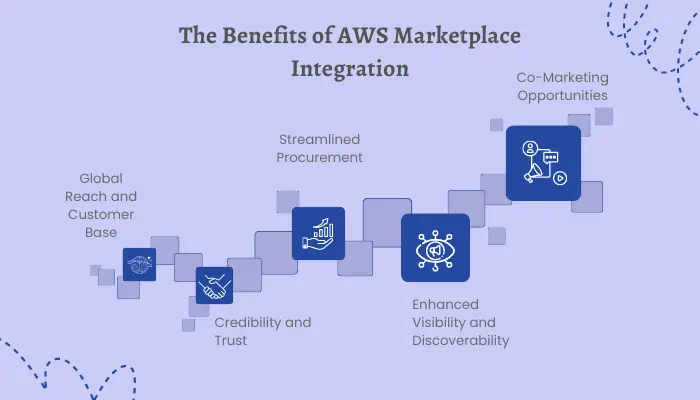
If you have chosen AWS marketplace for your project, it’s time to learn about benefit for AWS marketplace integration.
Well, this opens a lot of doors for you. In this section, we shall be discuss the benefits that comes with AWS marketplace integration:
Global Reach and Customer Base
One of the most significant advantages of AWS Marketplace integration is access to a global customer base.
With millions of active users across the globe, AWS Marketplace provides a unique opportunity to introduce your product to a diverse audience that may not have been accessible through traditional marketing efforts.
Moreover, this global reach enables you to expand your business horizons and tap into new markets, all while leveraging the infrastructure and resources of AWS.
Credibility and Trust
Integrating your product with AWS Marketplace instantly lends your offering a higher degree of credibility and trust.
In addition to this, AWS is renowned for its commitment to security, compliance, and best practices. When customers see your product listed on AWS Marketplace, they associate it with the rigorous standards upheld by AWS.
This built-in credibility can significantly influence customers’ decisions when considering your solution, leading to increased conversions and higher adoption rates.
Streamlined Procurement
The ease of procurement is a significant selling point of AWS Marketplace.
Customers can find, evaluate, and purchase your product directly from the platform, reducing friction in the buying process.
This streamlined approach accelerates the time-to-value for customers and minimizes the barriers to entry, making it more likely for them to explore and choose your offering.
Enhanced Visibility and Discoverability
Visibility is the cornerstone of success in any competitive marketplace.
AWS Marketplace’s intuitive search functionality and curated categories enhance your product’s visibility among potential customers actively seeking solutions in your domain.
By optimizing your product listing with relevant keywords, categories, and descriptions, you increase your chances of appearing in search results and gaining the attention of users interested in your niche.
Co-Marketing Opportunities
Collaborating with AWS on co-marketing initiatives can significantly amplify your brand’s visibility.
In addition, AWS Marketplace integration offers opportunities to participate in joint marketing campaigns, webinars, and events.
These collaborations not only increase your exposure but also position your brand alongside AWS, a recognized industry leader.
Co-marketing efforts can introduce your product to a broader audience, establish your authority in the field, and foster trust among potential customers.
And with this being said, it’s time to learn more about AWS marketplace procurement system integration in the next section.
Steps to Integrate Your Product with AWS Marketplace
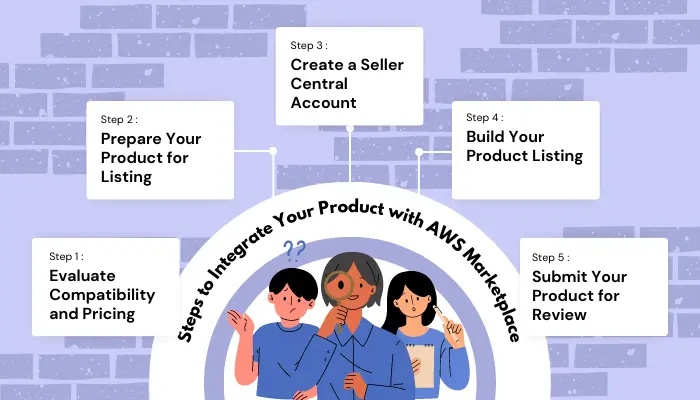
With all said and done, it’s time to learn AWS marketplace integration. There are various SaaS development companies who can help you with that.
But it doesn’t hurt to learn about the overall process right? Well, that said, let’s get right into it:
Step 1: Evaluate Compatibility and Pricing
Before embarking on the integration process, it’s crucial to ensure that your product aligns with AWS services and guidelines.
Evaluate the technical compatibility of your solution within the AWS ecosystem.
Plus, define a competitive pricing strategy that resonates with your target customers while considering factors such as licensing models, subscription plans, and pay-as-you-go options.
Step 2: Prepare Your Product for Listing
To stand out in the competitive AWS Marketplace integration, your product should be optimized for the cloud environment.
This entails adapting your solution to leverage AWS services efficiently, ensuring seamless integration and optimal performance.
Implement robust security measures that meet AWS’s stringent standards to inspire trust among potential customers.
Moreover, create comprehensive documentation that guides users through the deployment and utilization of your product, making it easier for them to get started.
Step 3: Create a Seller Central Account
To initiate your journey on AWS Marketplace, you must register as a seller on the AWS Marketplace Seller Central.
This account serves as the gateway to listing and managing your products.
In addition, AWS marketplace integration provide accurate and complete business information, including payment details, to establish your presence as a trustworthy vendor within the AWS ecosystem.
Step 4: Build Your Product Listing
Crafting a compelling and informative product listing is crucial for attracting potential customers.
Your product description should succinctly communicate its unique value proposition, emphasizing features that address specific pain points or challenges faced by your target audience.
Furthermore, select relevant categories and keywords that align with your product’s functionalities, ensuring that it appears in search results when users are looking for similar solutions.
Enrich your listing with high-quality images, videos, and graphics that showcase your product’s interface, usage scenarios, and benefits.
Step 5: Submit Your Product for Review
In last step of AWS marketplace integration, it’s time to submit the product for review.
After building your product listing, submit it for review by the AWS Marketplace team.
The review process ensures that your product meets the technical, security, and quality standards established by AWS.
Pay close attention to any feedback or recommendations provided by the review team, as addressing their suggestions can expedite the approval process and enhance the overall quality of your listing.
Enhancing Visibility with AWS Marketplace Features
Done with the AWS marketplace integration, it’s time to improve visibility. There are a range of AWS marketplace features which can help you with the same.
Therefore, with this being said, let’s get right into it:
A. Leveraging AWS Marketplace’s Discoverability
To optimize your product’s discoverability, choose relevant categories and keywords during the listing creation process.
These keywords should accurately reflect the core functionalities and benefits of your product.
By aligning your keywords with the terms potential customers are likely to use when searching for solutions, you increase the chances of your product appearing in their search results.
In addition to this, take advantage of AWS Marketplace’s recommendation engine.
This feature leverages customer browsing history, search patterns, and purchase behavior to suggest relevant products to users.
By optimizing your product listing and engaging customers through compelling content, you can enhance your product’s visibility within these personalized recommendations.
B. Capitalizing on Customer Reviews and Ratings
Following AWS marketplace Integration, it’s time to do this: Positive customer reviews and ratings play a pivotal role in building trust and credibility.
Plus, you should encourage satisfied customers to leave reviews detailing their positive experiences with your product. These testimonials serve as social proof and help potential customers make informed decisions.
And respond promptly to customer feedback, addressing any concerns or issues raised in a professional and constructive manner.
By actively engaging with customers, you demonstrate your commitment to their satisfaction and build a positive reputation within the AWS Marketplace community.
C. Utilizing AWS’s Global Customer Base
AWS Marketplace integration connects you with a diverse customer base encompassing startups, established enterprises, government entities, and more.
Moreover, you can tailor your marketing efforts to effectively target these different customer segments.
Craft messaging and campaigns that resonate with the unique needs, pain points, and priorities of each segment.
Additionally, via custom approach, you can maximize your appeal and visibility among various customer groups, ultimately driving higher adoption rates.
D. Leveraging Co-Marketing Opportunities
AWS Marketplace offers valuable co-marketing opportunities that can significantly boost your visibility and exposure.
Collaborate with AWS on joint marketing initiatives, such as webinars, whitepapers, and events. These collaborations allow you to tap into AWS’s established brand and customer trust, enhancing your credibility in the marketplace.
By participating in AWS-sponsored activities, you can position your product as an innovative solution within the AWS ecosystem, thereby increasing your product’s reach and credibility.
Best Practices for Optimizing Visibility
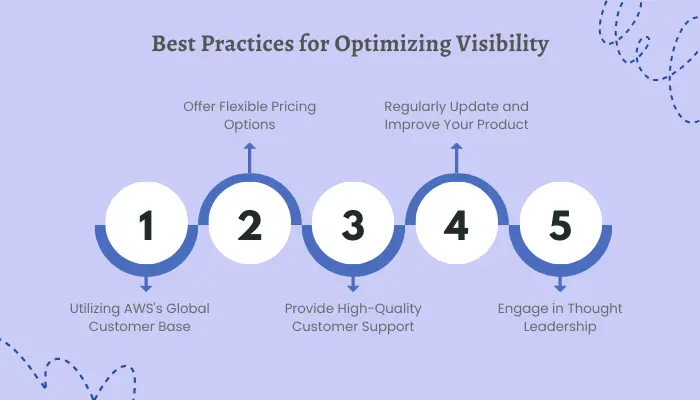
There are a range of things that you can do for AWS marketplace integration. And here, we shall be discussing some best practices that will help you improve visibility with AWS marketplace integration.
Therefore, with this being said, let’s get right into it, starting with the first tip which is:
Tip 1: Craft a Compelling Product Description
Your product description serves as the first point of contact with potential customers.
Craft a concise and compelling description that highlights the core features, benefits, and use cases of your solution.
Focus on addressing the pain points your product solves and the value it adds to customers’ operations.
Use clear and concise language that resonates with your target audience, avoiding technical jargon that might be unfamiliar to non-technical users.
Tip 2: Offer Flexible Pricing Options
AWS marketplace Pricing plays a pivotal role in customers’ decision-making processes. Consider offering flexible pricing models that cater to different customer preferences.
This could include options for free trials, pay-as-you-go plans, or subscription-based models.
Offering a range of pricing options accommodates varying budget constraints and encourages potential customers to explore and adopt your solution.
Tip 3: Provide High-Quality Customer Support
Responsive and reliable customer support is a cornerstone of customer satisfaction.
Ensure that you have a dedicated support team or resources in place to address customer inquiries, issues, and technical challenges promptly.
Moreover, quick and effective customer support not only enhances customer loyalty but also contributes to positive reviews and recommendations, which can significantly boost your product’s visibility.
Tip 4: Regularly Update and Improve Your Product
The technology landscape is dynamic and ever-evolving. Stay proactive by regularly updating and improving your product to align with the latest AWS services and features.
Regular updates demonstrate your commitment to innovation and customer satisfaction.
When customers see that your product remains relevant and up-to-date, they are more likely to engage with your offering and recommend it to others.
Tip 5: Engage in Thought Leadership
Lastly, establishing yourself as a thought leader in your industry enhances your brand’s visibility and credibility.
Share your expertise through blog posts, whitepapers, webinars, and speaking engagements. Address industry trends, challenges, and best practices to showcase your deep understanding of your domain.
In addition, thought leadership not only positions your product as a reliable solution but also garners respect from peers and customers alike.
Conclusion
AWS Marketplace integration presents a powerful opportunity to amplify your business’s visibility and reach within a global customer base. By following the comprehensive steps outlined in this guide, you can navigate the integration process successfully and leverage AWS Marketplace’s features to enhance your product’s visibility. The benefits of global reach, credibility, streamlined procurement, and co-marketing opportunities await those who embrace AWS Marketplace integration as a strategic growth initiative.
FAQ
AWS Marketplace is an online store by Amazon Web Services that enables customers to discover, purchase, and deploy software solutions that run on the AWS cloud infrastructure.
Integrating with AWS Marketplace grants your product global reach, credibility, and co-marketing opportunities. It simplifies procurement for customers and enhances your product’s visibility and discoverability.
Evaluate compatibility and pricing, prepare your product for listing, create a seller account, build a product listing with optimized content, and submit for review before going live on the marketplace.
Craft a compelling product description, use relevant keywords, offer flexible pricing options, and provide engaging images and videos to showcase your product’s features.
Leverage the recommendation engine, encourage customer reviews and ratings, collaborate with AWS for co-marketing, and tailor your messaging for AWS’s diverse customer base.
Engaging in thought leadership activities like webinars, blog posts, and whitepapers establishes your authority, enhances credibility, and positions your product as an innovative solution.
Offer responsive customer support, regularly update your product, and listen to customer feedback to improve their experience and garner positive reviews.
If your product is cloud-compatible and aligns with AWS services, it likely qualifies for integration. Evaluate technical compatibility and ensure robust security measures are in place.
Businesses of all sizes, ranging from startups to enterprises, can benefit from AWS Marketplace integration. It provides access to a diverse customer base and co-marketing opportunities.

Niketan Sharma is the CTO of Nimble AppGenie, a prominent website and mobile app development company in the USA that is delivering excellence with a commitment to boosting business growth & maximizing customer satisfaction. He is a highly motivated individual who helps SMEs and startups grow in this dynamic market with the latest technology and innovation.
Table of Contents




No Comments
Comments are closed.